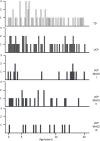Actigraph assessment for measuring upper limb activity in unilateral cerebral palsy
- PMID: 30795810
- PMCID: PMC6387534
- DOI: 10.1186/s12984-019-0499-7
Actigraph assessment for measuring upper limb activity in unilateral cerebral palsy
Abstract
Background: Detecting differences in upper limb use in children with unilateral cerebral palsy (UCP) is challenging and highly dependent on examiner experience. The recent introduction of technologies in the clinical environment, and in particular the use of wearable sensors, can provide quantitative measurement to overcome this issue. This study aims to evaluate ActiGraph GT3X+ as a tool for measuring asymmetry in the use of the two upper limbs (ULs) during the assessment with a standardized clinical tool, the Assisting Hand Assessment (AHA) in UCP patients aged 3-25 years compared to age-matched typically developing (TD) subjects.
Methods: Fifty children with UCP and 50 TD subjects were assessed with AHA while wearing ActiGraphs GT3X+ on both wrists. The mean activity of each hand (dominant and non-dominant, MADH and MANDH, respectively) and the asymmetry index (AI) were calculated. Two linear mixed model analyses were carried out to evaluate how dependent actigraphic variables (i.e. MANDH and AI) varied by group (TD vs UCP) and among levels of manual ability based on Manual Ability Classification System (MACS). In both models age, sex, side of hemiplegia, presence/absence of mirror movements were specified as random effects.
Results: The MANDH was significantly lower in UCP compared to TD, while the AI was significantly higher in UCP compared to TD. Moreover, in UCP group there were significant differences related to MACS levels, both for MANDH and AI. None of the random variables (i.e. age, sex, side, presence/absence of mirror movements) showed significant interaction with MANDH and AI.
Conclusions: These results confirm that actigraphy could provide, in a standardized setting, a quantitative description of differences between upper limbs activity.
Trial registration: ClincalTrials.gov, NCT03054441 . Registered 15 February 2017.
Keywords: Actigraphy; Arm movements; Assisting hand assessment; Congenital hemiplegia; Information and communications technology (ICT).
Conflict of interest statement
Ethics approval and consent to participate
The study has been approved by Tuscan Region Paediatric Ethics Committee (Italy) (no. 78/2016).
Consent for publication
Not applicable.
Competing interests
The authors declare that they have no competing interests.
Publisher’s Note
Springer Nature remains neutral with regard to jurisdictional claims in published maps and institutional affiliations.
Figures


Similar articles
-
Wearable sensors for measuring spontaneous upper limb use in children with unilateral cerebral palsy and typical development.J Neuroeng Rehabil. 2025 Apr 3;22(1):71. doi: 10.1186/s12984-025-01601-3. J Neuroeng Rehabil. 2025. PMID: 40181251 Free PMC article.
-
Randomized trial of observation and execution of upper extremity actions versus action alone in children with unilateral cerebral palsy.Neurorehabil Neural Repair. 2013 Nov-Dec;27(9):808-15. doi: 10.1177/1545968313497101. Epub 2013 Jul 25. Neurorehabil Neural Repair. 2013. PMID: 23886886 Clinical Trial.
-
Validity of semi-quantitative scale for brain MRI in unilateral cerebral palsy due to periventricular white matter lesions: Relationship with hand sensorimotor function and structural connectivity.Neuroimage Clin. 2015 Apr 9;8:104-9. doi: 10.1016/j.nicl.2015.04.005. eCollection 2015. Neuroimage Clin. 2015. PMID: 26106533 Free PMC article.
-
Constraint-induced movement therapy in children with unilateral cerebral palsy.Cochrane Database Syst Rev. 2019 Apr 1;4(4):CD004149. doi: 10.1002/14651858.CD004149.pub3. Cochrane Database Syst Rev. 2019. PMID: 30932166 Free PMC article.
-
Rehabilitation and neuroplasticity in children with unilateral cerebral palsy.Nat Rev Neurol. 2015 Jul;11(7):390-400. doi: 10.1038/nrneurol.2015.97. Epub 2015 Jun 16. Nat Rev Neurol. 2015. PMID: 26077839 Review.
Cited by
-
Time-matched accelerometers on limbs and waist in children with CP give new insights into real-life activities after botulinum toxin treatment: A proof of concept study.J Pediatr Rehabil Med. 2023;16(1):125-137. doi: 10.3233/PRM-210112. J Pediatr Rehabil Med. 2023. PMID: 36314229 Free PMC article.
-
Wrist-Worn devices to encourage affected upper limb movement in unilateral cerebral palsy: Participatory design workshops.Front Rehabil Sci. 2022 Dec 21;3:1021760. doi: 10.3389/fresc.2022.1021760. eCollection 2022. Front Rehabil Sci. 2022. PMID: 36619529 Free PMC article.
-
Efficacy of integrating a semi-immersive virtual device in the HABIT-ILE intervention for children with unilateral cerebral palsy: a non-inferiority randomized controlled trial.J Neuroeng Rehabil. 2023 Jul 29;20(1):98. doi: 10.1186/s12984-023-01218-4. J Neuroeng Rehabil. 2023. PMID: 37516873 Free PMC article. Clinical Trial.
-
Trends and Innovations in Wearable Technology for Motor Rehabilitation, Prediction, and Monitoring: A Comprehensive Review.Sensors (Basel). 2024 Dec 13;24(24):7973. doi: 10.3390/s24247973. Sensors (Basel). 2024. PMID: 39771710 Free PMC article. Review.
-
Bimanual movements in children with cerebral palsy: a systematic review of instrumented assessments.J Neuroeng Rehabil. 2023 Feb 27;20(1):26. doi: 10.1186/s12984-023-01150-7. J Neuroeng Rehabil. 2023. PMID: 36849971 Free PMC article.
References
-
- Cioni G, Sgandurra G, Muzzini S, Paolicelli PB, Ferrari A. Forms of hemiplegia In: The spastic forms of cerebral palsy: a guide to the assessment of adaptive functions, edited by Cioni G and Ferrari A. Milano: Springer-Verlag, 2010, pp 331–356.
Publication types
MeSH terms
Associated data
LinkOut - more resources
Full Text Sources
Medical
Miscellaneous

